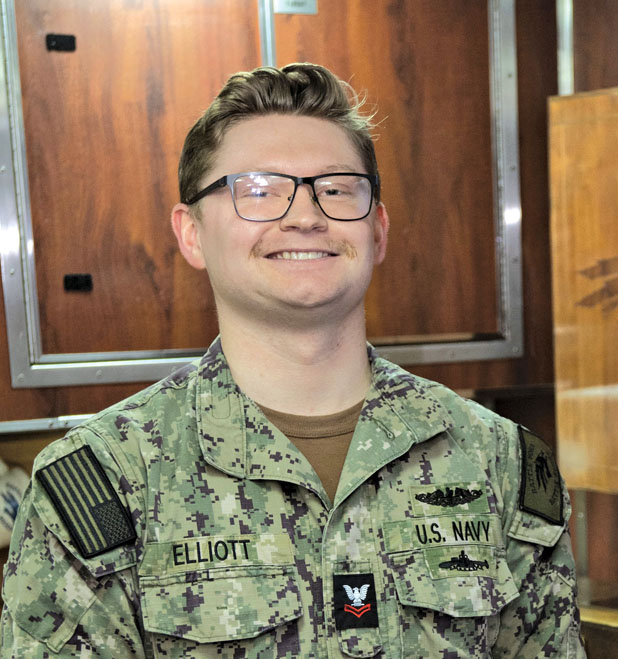Petty Officer 2nd Class Zane Elliott, a native of Oklahoma City, Oklahoma, is one of the sailors serving aboard USS Nevada, continuing the U.S. Navy’s 124-year tradition of service under the sea to help ensure Americans’ safety.
Elliott graduated from Moore High School in 2019.
The skills and values needed to succeed in the Navy are similar to those found in Oklahoma City.
“My parents always instilled in me the importance of having a good work ethic,” said Elliott. “They would always tell me to outwork my coworkers and to work the hardest that I can. That lesson is important here because the Navy needs sailors working hard to succeed.”
Elliott joined the Navy four years ago. Today, Elliott serves as a fire control technician.
“My uncle was in the Air Force and I saw that he was living a comfortable lifestyle,” said Elliott. “He lived in a big house and bought a new truck almost every two years. So, I tried to originally join the Air Force but they wouldn’t offer me a sign-on bonus. However, my best friend joined the Navy about a year before me. He gave me his recruiter’s number and the rest is history.”
Known as America’s “Apex Predators,” the Navy’s submarine force operates a large fleet of technically advanced vessels. These submarines are capable of conducting rapid defensive and offensive operations around the world, in furtherance of U.S. national security. A major component of that maritime security is homeported at Naval Base Kitsap, in Washington.
There are three basic types of submarines: fast-attack submarines (SSN), ballistic-missile submarines (SSBN) and guided-missile submarines (SSGN).
Fast-attack submarines are designed to hunt down and destroy enemy submarines and surface ships; strike targets ashore with cruise missiles; carry and deliver Navy SEALs; conduct intelligence, surveillance, and reconnaissance missions; and engage in mine warfare. The Virginia-class SSN is the most advanced submarine in the world today. It combines stealth and payload capability to meet combatant commanders’ demands in this era of strategic competition.
The Navy’s ballistic-missile submarines, often referred to as “boomers,” serve as a strategic deterrent by providing an undetectable platform for submarine-launched ballistic missiles. SSBNs are designed specifically for stealth, extended patrols and the precise delivery of missiles. The Columbia-class SSBN will be the largest, most capable and most advanced submarine produced by the U.S. – replacing the current Ohio-class ballistic-missile submarines to ensure continuous sea-based strategic deterrence into the 2080s.
Guided-missile submarines provide the Navy with unprecedented strike and special operation mission capabilities from a stealthy, clandestine platform. Each SSGN is capable of carrying 154 Tomahawk cruise missiles, plus a complement of heavyweight torpedoes to be fired through four torpedo tubes.
Strategic deterrence is the nation’s ultimate insurance program, according to Navy officials. As a member of the submarine force, Elliott is part of a rich 124-year history of the U.S. Navy’s most versatile weapons platform, capable of taking the fight to the enemy in the defense of America and its allies.
The Pacific Submarine Force maximizes the Navy’s strengths of knowledge, stealth, agility, firepower and endurance.
“The men and women of the Pacific Submarine Force are among our best and brightest Americans,” said Rear Adm. Richard Seif, Commander, Submarine Force U.S. Pacific Fleet. “The pace of activity across the force is eye-watering, and our ability to remain on-scene, unseen, is only possible due to their hard work and critical thinking. We are lethal, far-reaching, and incredibly capable, and we deter aggression through our demonstrated advantage in the undersea domain.”
With 90% of global commerce traveling by sea and access to the internet relying on the security of undersea fiber optic cables, Navy officials continue to emphasize that the prosperity of the United States is directly linked to recruiting and retaining talented people from across the rich fabric of America.
Elliott serves a Navy that operates far forward, around the world and around the clock, promoting the nation’s prosperity and security.
“We will earn and reinforce the trust and confidence of the American people every day,” said Adm. Lisa Franchetti, chief of naval operations. “Together we will deliver the Navy the nation needs.”
Elliott has many opportunities to achieve accomplishments during military service.
“I am most proud of being named Blue Jacket of the Year for USS Nevada because, to me, that meant I was the hardest working sailor on the boat,” said Elliott. “I am also proud of leading the charge for qualifying 50 sailors in submarines. I am proud of that because that is what we work toward in the submarine community. It took me a long time to earn my dolphins but it feels good that now I can help other sailors earn theirs.”
Elliott can take pride in serving America through military service.
“The Navy has been a great stepping stone in my life,” said Elliott. “I have been able to get qualifications and certifications that I wouldn’t be able to afford or would have gotten otherwise. Now when I get out, I will also be able to go to college while being paid.”
Elliott is grateful to others for helping make a Navy career possible.
“I want to thank Ensign Curtis Labrone for getting me to join the Navy,” added Elliott. “I also want to thank Fire Control Technician 2nd Class Dillon Porter and Fire Control Technician 1st Class Greg Moore for mentoring me. Lastly, I want to thank Chief Fire Control Technician Kevin Behnken for being a great leader.”















